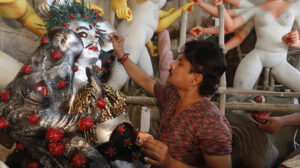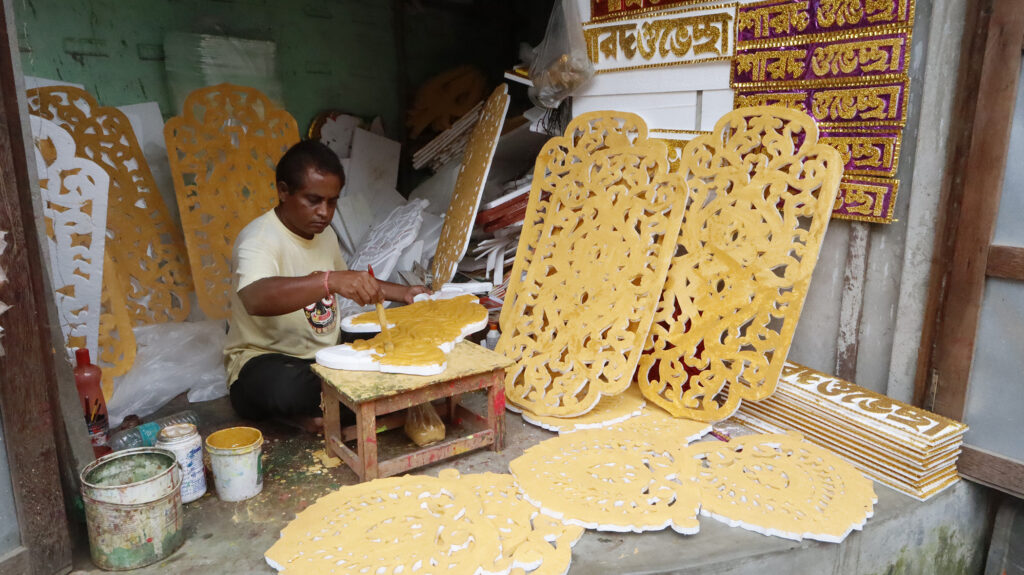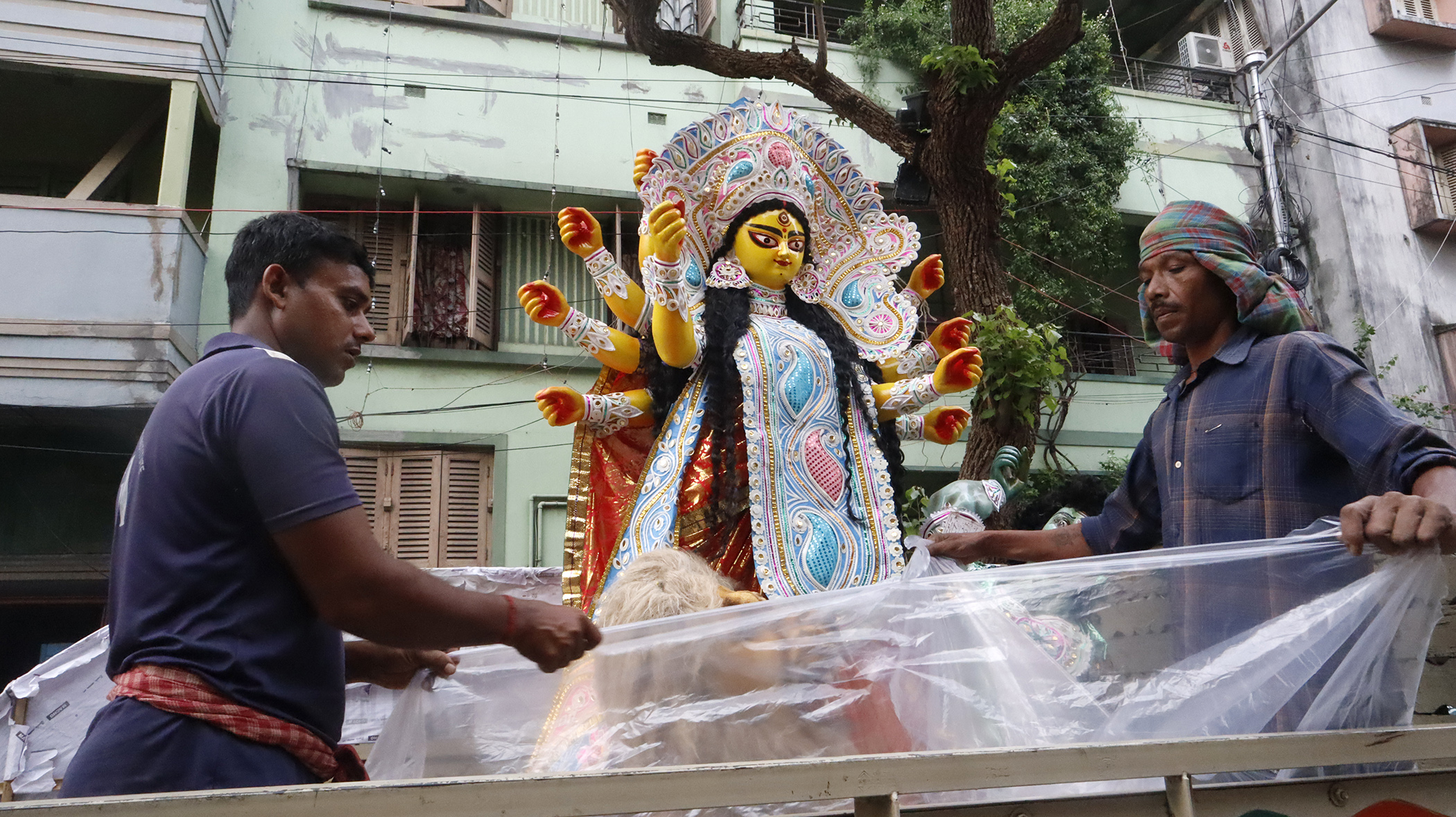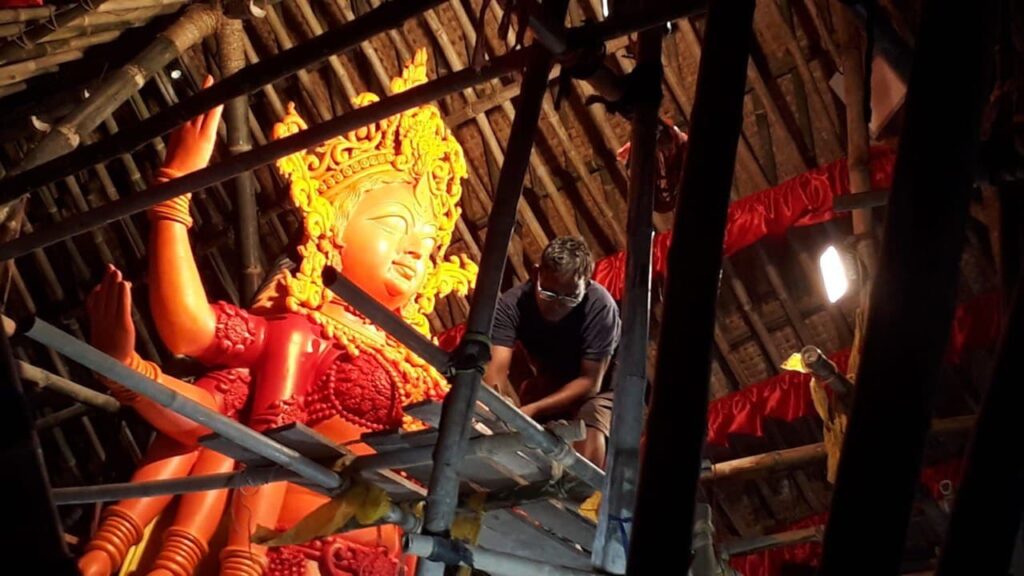A narrow lane beside the tramline winds its way inside North Kolkata’s potter’s hub, locally known as Patuapara in Kumartuli. Rows of shops displaying decorative items and ornaments meant for idols made the entrance to the locality congested. Artisans were seen busy at their workshops giving finishing touches before delivering the idols.
“This year I have made 12 idols,” said Maya Pal, an elderly woman artisan who has  been making idols for the past 40 years. “The situation is far better than the last year. Last year there was nothing; we had suffered a lot,” she told The Voices.
been making idols for the past 40 years. “The situation is far better than the last year. Last year there was nothing; we had suffered a lot,” she told The Voices.
She learnt the art of making idols from her husband, who is no more. After his death, she has taken up the family business. “There are thousands of artisans like me in Kumartuli. Everyone has got orders this year,” she said. Before the pandemic, Ms. Pal used to make 19-20 idols, but this year, she got orders for 12 idols. “There were queries for more but I don’t make idols without prior orders”, she said even as she got busy drawing the eye lines for one of the Durga idols.
The main thoroughfare in this neighbourhood branched out to several smaller lanes and by-lanes, each of them lined by rows of shops. Ahead of the festive season, the artisans manning the shops were visibly busy getting the idols and ornaments ready before the deadline.

Not far away, Mukti Pramanik was busy at her tiny workshop cutting ornaments for the idols. She makes zari and sholapith ornaments. Zari is a golden-coloured thread used for decoration in clothing while sholapith is the milky-white core of an aquatic herb (Scientific name: Aeschynomene aspera) found widely in marshlands that generations of craftspeople in Bengal have used to create decorative objects.
“My family has been running this business for the past 35 years,” Ms. Pramanik told The Voices. “Earlier, I used to get so many orders that I had to hire 8-10 workers. But after COVID-19 and the lockdown, the number of orders dropped,” she lamented. “Now, my son and daughter-in-law are enough to help me. The pandemic has ruined our business.”
Even if there were more orders, meeting the demand would have been difficult as the raw materials meant for making the products were not available in the market, she pointed out.
Rudrajit Pal, another artisan, told The Voices that orders for the idols would start

from June, soon after the Rath Yatra, a Hindu religious festival associated with Lord Jagannath held in Puri, Odisha. This year, the second wave of COVID-19 pandemic hit Bengal hard between April and June (which also coincided with the post-election period in West Bengal). “Perhaps people were confused whether to place orders for idols or not looking at the prevailing situation. Besides, the puja organisers also found it difficult to attract sponsorships during such uncertainty,” Mr. Pal added.
The puja organised by the Kasi Bose Lane Durga Puja Samity in Manicktala in North

Kolkata is one of the several big-budget pujas in the city. Soumen Ghosh, a member of the organising committee, sees a silver lining this year, when compared to last year. “West Bengal faced two severe cyclones recently – Amphan and Yaas. Most of these people come from the remote villages of South Bengal. The cyclone devastated their crops and cultivable lands. At least they are earning something this year. Last year they had nothing. Their families had nothing to eat or to wear. They had to depend only on relief,” Mr. Ghosh remarked. With the situation showing signs of returning to normal, the workers who put up the pandals, the labourers who carried the idols on their shoulders, the dhakis who beat the drums ushering in the festivities – all of them have come here to earn so that they could run their families. “A big event like the Durga Puja supports a big number of people economically. It helps a large number of people earn a handsome chunk of money once a year,” Mr. Ghosh added.

The economic activities represented by these micro and small enterprises that are predominantly traditional and artisan-based come under the label of creative industries. They have strong cultural roots and they thrive generating or using knowledge and information, thus making themselves a part of what is known as creative economy.

The creative economy around the Durga Puja in Kolkata has been growing year on year, till the pandemic struck. While there has seldom been an attempt to measure the size of this creative economy, the West Bengal Government had, through an MoU signed in July 2018, entrusted the task of mapping the creative economy around the Durga Puja to the British Council. The report, which was released early last month, pegged the economic worth of creative industries around the Durga Puja to be Rs. 32,277 crore, which is equivalent to 2.58% of the GDP of West Bengal in 2019-20.
Table 1: Sector-wise break up of the economic worth
Sector | Turnover (in Rupees) | Comments |
Installation, Art and Decoration | 860 crore | Kolkata accounts for 15% share of pandal-making industry in West Bengal |
Idol making | 260-280 crore | 40% of idol-making studios in Kumortoli are older than 60 years |
Lighting and Illumination | 205 crore | 52 MW electricity consumed by pujas in Kolkata in 2019 |
Literature and Publishing | 260-270 crore | Special puja edition magazines’ revenues amount to Rs. 15 crore |
Sponsorships | 318 crore | Long-term sponsors include large MNCs and major Indian corporate firms |
Retail | 27,364 crore | 100% spike in sales during festive season due to bonuses and offers |
Crafts and Design (puja utensils) | 2.1 crore | Source of livelihood for workers engaged in pandal-making, clothing, ancillary craft industry etc. |
Films and Entertainment | 53.2 crore | 70% of big banner Bengali releases are done during the festive season |
Food and Beverages | 2,854 crore | Equates to per capita spend of Rs. 285 |
Advertisement | 504 crore | Out of Home industry space in pandals worth Rs. 35 crore |
Source: Report on Mapping the Creative Economy around Durga Puja 2019, British Council and Department of Tourism, Government of West Bengal
The research was led by Queen Mary University of London and supported by IIT Kharagpur while the quantitative report was prepared by Smart Cube India Private Limited.
The report further stated that there was a 120% spike in bus passengers and an 11% spike in air and rail traffic, while the Kolkata Metro recorded nearly a million passengers on October 3, 2019, which is a record.
At the release of the report, West Bengal Chief Minister Mamata Banerjee observed that the size of the economy was massive, especially for a seven-day festival. It was comparable to the GDP of Maldives. “We would urge UNESCO to declare Durga Puja as one of the best festivals in the world,” she had said.
In her introduction to the report, Barbara Wickham, Director, India British Council, said that this complex research was probably the first of its kind in India done on this scale. It was done based on the same methodology that mapped the Edinburgh and Rio festivals.
While the figures in the report depict the pre-pandemic situation, a probable follow-up study using the same methodology could provide an insight into the impact of the pandemic.
Vikash Agarwal, President, Indian Chamber of Commerce, was quoted by India Today as saying that the sectoral distribution of the post-pandemic recovery was different, pointing to trends of a K-shaped recovery and not a V-shaped one. While government employees had income growth and had been able to maintain spending momentum, but all private sector employees were not so fortunate. “Some are coping with job loss and some with wage cuts, while some have very high incomes. The result is, along with income inequality, the demand is more affordable with cash purchases without GST and formal invoicing,” he added.

Cover image by: Sabyasachi Bandyopadhyay
Photographs by: Arpita Dey
Edited by: Saptarishi Bhattacharya

